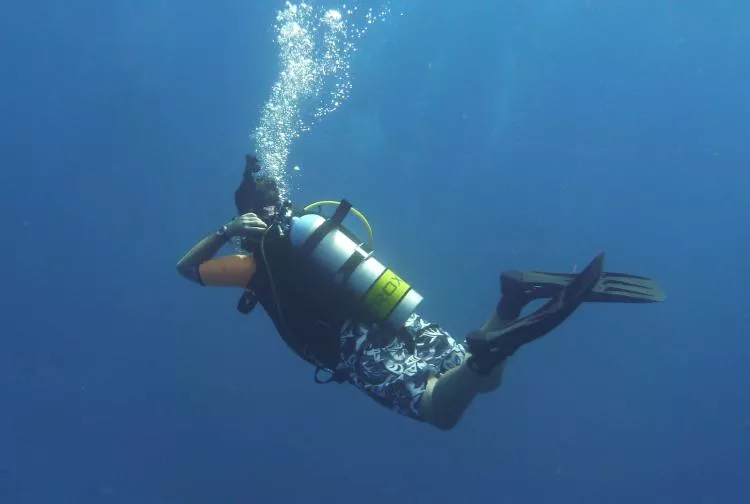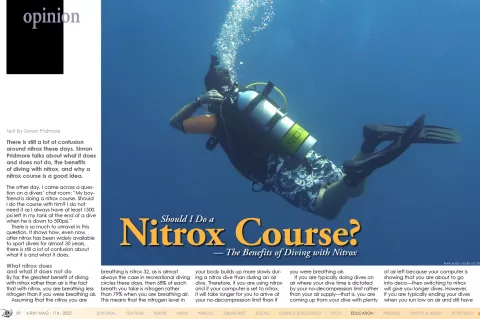There is still a lot of confusion around nitrox these days. Simon Pridmore talks about what it does and does not do, the benefits of diving with nitrox, and why a nitrox course is a good idea.
Contributed by
The other day, I came across a question on a divers’ chat room: “My boyfriend is doing a nitrox course. Should I do the course with him? I do not need it as I always have at least 1500 psi left in my tank at the end of a dive when he is down to 500 psi.”
There is so much to unravel in this question. It shows how, even now, after nitrox has been widely available to sport divers for almost 30 years, there is still a lot of confusion about what it is and what it does.
What nitrox does and what it does not do
By far, the greatest benefit of diving with nitrox rather than air is the fact that with nitrox, you are breathing less nitrogen than if you were breathing air.
Assuming that the nitrox you are breathing is nitrox 32, as is almost always the case in recreational diving circles these days, then 68% of each breath you take is nitrogen rather than 79% when you are breathing air. This means that the nitrogen level in your body builds up more slowly during a nitrox dive than during an air dive. Therefore, if you are using nitrox and if your computer is set to nitrox, it will take longer for you to arrive at your no-decompression limit than if you were breathing air.
If you are typically doing dives on air where your dive time is dictated by your no-decompression limit rather than your air supply—that is, you are coming up from your dive with plenty of air left because your computer is showing that you are about to go into deco—then switching to nitrox will give you longer dives. However, if you are typically ending your dives when you run low on air and still have plenty of no-decompression time remaining, then switching to nitrox will make no difference at all to how long your dive lasts.
Switching to nitrox has absolutely no effect on how quickly you use up your breathing gas. There are plenty of techniques that will help you reduce your consumption rate, but that is a separate discussion. My book Scuba Confidential has a whole chapter on it.
Why a nitrox course is a good thing to do
So, should you do a nitrox course? Yes, you should, and this is why.
As you gain more diving experience, you will reach a point where two things start happening. First, you no longer use up your breathing gas as fast as you did in the beginning; and second, you start doing deeper and more challenging dives. This is when you will want to use nitrox to give you more dive time.
As you get more experienced and begin to travel farther afield to dive, you will probably start doing extended trips with three, four, even five dives a day. Using nitrox with schedules like these will extend your dive time, which is especially true on later dives in the day when your no-decompression time on air may become quite short.
If your dive partner is using nitrox, then, no matter what your consumption rate is, it is good for both of you to be on nitrox, so that your computer profiles match as closely as possible. If you are both breathing the same gas, you will have a good idea of your partner’s remaining no-decompression time, simply by looking at your own computer. If one of you is using nitrox and the other is using air, then, especially if you are doing multiple dives in a day, the remaining no-decompression time figures on your respective computers will be very different.
Here is a good example of what can easily happen when you have a team of divers, some of whom are using air and others nitrox. It happened when I was diving in Lembeh Strait a few years ago. There were six divers in our group. Two of the diving pairs were using nitrox 32; the third pair was diving on air. It was the second dive of the day, and we were diving a site where the seabed was at a constant depth of 20m (66 ft) or so.
Of course, this being Lembeh Strait, we found lots of cool critters, and everybody got carried away taking pictures. The air divers forgot to check their gauges, probably assuming subconsciously that they still had plenty of no-decompression time left because nobody else in the group had started ascending. Perhaps they had their computer alarms switched off too, or maybe they ignored them. As for the nitrox divers, they forgot that they had air divers in the group and assumed that if they had plenty of no-decompression time left, then everybody did.
It was only when the group returned to the anchor line that the air divers glanced at their gauges and noticed to their horror that they had accumulated a huge decompression burden. Fortunately, as the team had stayed together, the nitrox divers were able to stay with the air divers and help them out with gas sharing during their extended stops and everyone was fine. But it was a good reminder for all of us. From then on, we always made a point of double-checking between buddy teams during our dives.
What else nitrox can do
Using nitrox can also help you add an extra margin of safety to your diving. If you are older or out of shape (or both), or if you are any age or shape and just want to dive conservatively, especially if you are on a trip where you will be doing multiple dives over multiple days in a remote area far from a recompression chamber, then a great technique is to use nitrox and have your computer set to air.
You will not benefit from the extra no-decompression time that diving with nitrox can offer, but, on every dive, you will be building in a margin of safety as far as decompression sickness is concerned, as your computer thinks you are breathing 79% nitrogen with each breath, when in fact you are breathing only 68%. This is a completely safe procedure to follow as long as you never exceed the maximum operating depth (MOD) of the nitrox.
This maximum depth for nitrox 32 depends on what maximum PO2 you choose and set in your computer, as follows:
Max PO2 = 1.4 / MOD = 33m (110ft)
Max PO2 = 1.5 / MOD = 36m (120ft)
Max PO2 = 1.6 / MOD = 39m (130ft)
Myth or reality?
A couple of final points. In the early days of sport nitrox diving, it was thought that diving with nitrox would make a diver less susceptible to narcosis. However, research subsequently showed that this is not the case, even though nitrox has a lower nitrogen content. This is because oxygen under pressure produces narcosis too. So, you must be equally vigilant on deeper dives, whether you are breathing air or nitrox.
However, another claim made for nitrox—that you are less tired after a nitrox diving day than after an air diving day—is a matter of debate. Scientific experiments have failed to find any objective proof that this is the case, but I remember when I ran liveaboard trips in the past and everyone was using air, some divers found it hard to keep their eyes open during dinner and by 8 p.m. we were all in bed. Nowadays, when everyone is using nitrox, the chatting and storytelling goes on long after the crew has cleared the dishes.
I notice the difference. See if you do too.




























